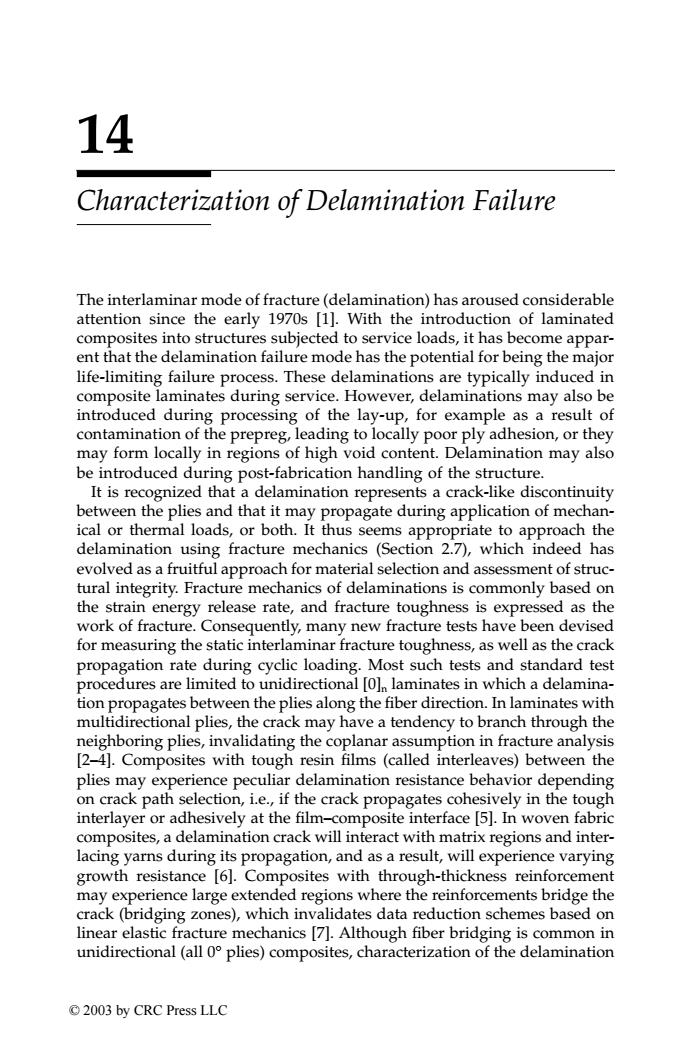正在加载图片...

14 Characterization of Delamination Failure The interlaminar mode of fracture(delamination)has aroused considerable attention since the early 1970s [1].With the introduction of laminated composites into structures subjected to service loads,it has become appar- ent that the delamination failure mode has the potential for being the major life-limiting failure process.These delaminations are typically induced in composite laminates during service.However,delaminations may also be introduced during processing of the lay-up,for example as a result of contamination of the prepreg,leading to locally poor ply adhesion,or they may form locally in regions of high void content.Delamination may also be introduced during post-fabrication handling of the structure. It is recognized that a delamination represents a crack-like discontinuity between the plies and that it may propagate during application of mechan- ical or thermal loads,or both.It thus seems appropriate to approach the delamination using fracture mechanics (Section 2.7),which indeed has evolved as a fruitful approach for material selection and assessment of struc- tural integrity.Fracture mechanics of delaminations is commonly based on the strain energy release rate,and fracture toughness is expressed as the work of fracture.Consequently,many new fracture tests have been devised for measuring the static interlaminar fracture toughness,as well as the crack propagation rate during cyclic loading.Most such tests and standard test procedures are limited to unidirectional [Ol laminates in which a delamina- tion propagates between the plies along the fiber direction.In laminates with multidirectional plies,the crack may have a tendency to branch through the neighboring plies,invalidating the coplanar assumption in fracture analysis [2-4].Composites with tough resin films(called interleaves)between the plies may experience peculiar delamination resistance behavior depending on crack path selection,i.e.,if the crack propagates cohesively in the tough interlayer or adhesively at the film-composite interface [5].In woven fabric composites,a delamination crack will interact with matrix regions and inter- lacing yarns during its propagation,and as a result,will experience varying growth resistance [6].Composites with through-thickness reinforcement may experience large extended regions where the reinforcements bridge the crack(bridging zones),which invalidates data reduction schemes based on linear elastic fracture mechanics [7].Although fiber bridging is common in unidirectional (all 0 plies)composites,characterization of the delamination ©2003 by CRC Press LLC14 Characterization of Delamination Failure The interlaminar mode of fracture (delamination) has aroused considerable attention since the early 1970s [1]. With the introduction of laminated composites into structures subjected to service loads, it has become apparent that the delamination failure mode has the potential for being the major life-limiting failure process. These delaminations are typically induced in composite laminates during service. However, delaminations may also be introduced during processing of the lay-up, for example as a result of contamination of the prepreg, leading to locally poor ply adhesion, or they may form locally in regions of high void content. Delamination may also be introduced during post-fabrication handling of the structure. It is recognized that a delamination represents a crack-like discontinuity between the plies and that it may propagate during application of mechanical or thermal loads, or both. It thus seems appropriate to approach the delamination using fracture mechanics (Section 2.7), which indeed has evolved as a fruitful approach for material selection and assessment of structural integrity. Fracture mechanics of delaminations is commonly based on the strain energy release rate, and fracture toughness is expressed as the work of fracture. Consequently, many new fracture tests have been devised for measuring the static interlaminar fracture toughness, as well as the crack propagation rate during cyclic loading. Most such tests and standard test procedures are limited to unidirectional [0]n laminates in which a delamination propagates between the plies along the fiber direction. In laminates with multidirectional plies, the crack may have a tendency to branch through the neighboring plies, invalidating the coplanar assumption in fracture analysis [2–4]. Composites with tough resin films (called interleaves) between the plies may experience peculiar delamination resistance behavior depending on crack path selection, i.e., if the crack propagates cohesively in the tough interlayer or adhesively at the film–composite interface [5]. In woven fabric composites, a delamination crack will interact with matrix regions and interlacing yarns during its propagation, and as a result, will experience varying growth resistance [6]. Composites with through-thickness reinforcement may experience large extended regions where the reinforcements bridge the crack (bridging zones), which invalidates data reduction schemes based on linear elastic fracture mechanics [7]. Although fiber bridging is common in unidirectional (all 0° plies) composites, characterization of the delamination TX001_ch14_Frame Page 185 Saturday, September 21, 2002 5:09 AM © 2003 by CRC Press LLC